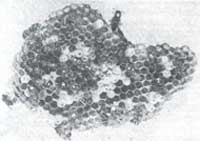Paper wasps early casteists
 WASPS, bees and ants are known to live in highly organised colonies with an elaborate division of labour among the occupants, who are separated into different "castes", each performing specific functions, and who are also physically different and with a rank in colony hierarchy.
WASPS, bees and ants are known to live in highly organised colonies with an elaborate division of labour among the occupants, who are separated into different "castes", each performing specific functions, and who are also physically different and with a rank in colony hierarchy.
However, Ropalidia rufoplagiata wasps, studied by researchers at the Indian Institute of Science in Bangalore, does not have castes distinguishable by common physical characteristics. Though discovered early this century, scientists had never studied the behaviour of these wasps, commonly known as paper wasps because they build papery nests from wood cellulose.
Ropalidia is confined to the tropical and subtropical regions of Africa, Australia and southern Asia. Usually, a single egg-layer is clearly distinguishable in their colonies, as in the more evolved insects. But, unlike their relatives in the genus, the Ropalidia rufoplagiata wasp colony has numerous egg-layers. Anindya Sinha, the main IISc investigator, found as many as 70 per cent of the female wasps in the colony were egg-layers, with some laying eggs more than once. The colony's other female members spent most of their time foraging and feeding the larvae. The egg-layers never went out to gather food, but undertook responsibility, instead, for nest maintenance, including breaking down walls of unused cells and extending old cell walls. Interestingly, Sinha found the foragers were the younger wasps, whereas the egg-layers were older.
Sinha says that unlike other social insects, the paper wasps displayed no hierarchy in their colony. The egg-layers rarely interacted with the foragers, though some interaction did exist among the egg-layers.
Also, unlike higher social insects, the more dominant egg-layers did not lay more eggs or produce more successful offspring. In colonies of higher social insects, usually only one dominant queen takes over the reproductive role for the entire colony. In fact, says Sinha, the more prolific Ropalidia rufoplagiata egg-layers were found to be less aggressive.
The number of empty cells determine the number of eggs an individual lays. Egg-layers are notorious for eating eggs that belong to others and this results in egg guarding, which has never been reported before in the genus Ropalidia. Sinha found that the egg-layer first cannibalises another's egg, cleans out the now empty cell, lays its own egg and then sticks its head into the cell, blocking the entrance with its body to protect the egg. The insects are extremely prone to attack by other insects at this time, adds Sinha.
The scientists postulate that the unique social organisation of Ropalidia rufoplagiata could be an intermediate evolutionary stage between casteless group living and the emergence of a caste hierarchy. The insects within a paper wasp community are not closely related, because they are the offspring of different mothers and fathers, unlike honey bees, for instance, which are related intimately because they share a common mother. Scientists are still unsure why paper wasps would choose, nevertheless, to live as a community.
"We are probably seeing an early stage in the evolution of social behaviour," explains Sinha, "when the chances of survival in an adverse environment of the individual was higher in a group than alone."
